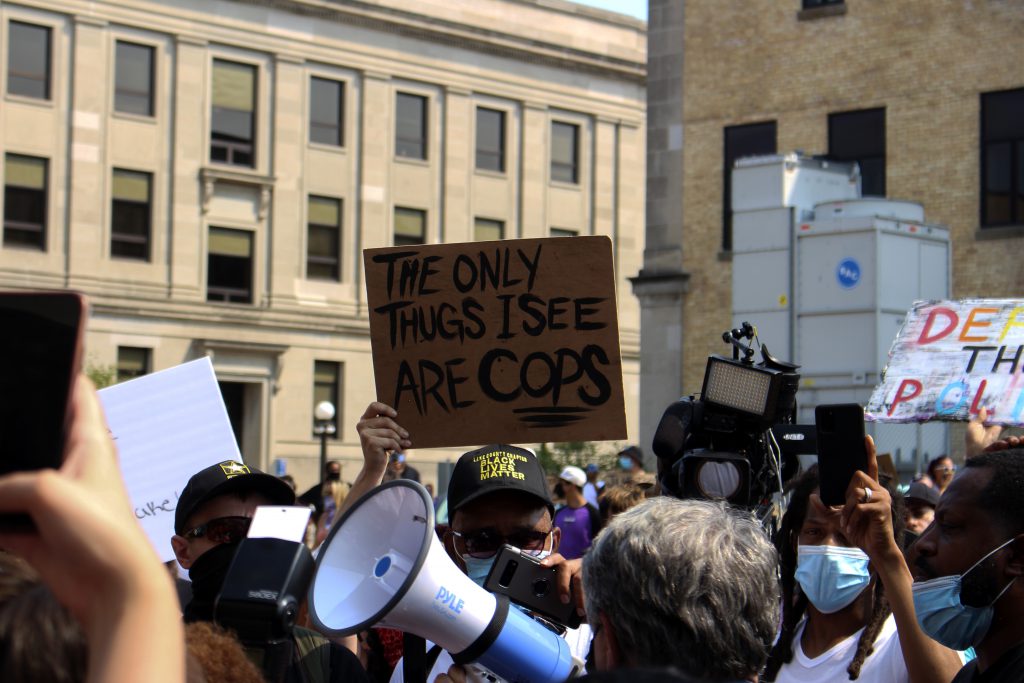One Year After Jacob Blake Shooting Kenosha Seeks Answers
Still dealing with fallout from police shooting, protests, killing of protestors.

Kenosha Mayor John Antaramian attempts to speak with a crowd of protesters outside the Kenosha Public Safety Building. Photo by Henry Redman/Wisconsin Examiner.
The incident, which started as a domestic call during a child’s birthday party, took place on a Kenosha street on a Sunday afternoon in late August. Neighbors took a cell phone video as Kenosha police officer Rusten Sheskey fired eight shots into Jacob Blake’s back. The video went viral, quickly igniting a firestorm. The small city on Lake Michigan, near the Illinois border, became the center of a nationwide reckoning over race and police violence. To this day Blake, who was 29 years old when he was shot, continues to recover and is paralyzed from the waist down.
The cable TV crews and Air Force One are long gone. What’s left is a community trying to move forward as politicians continue to use the Jacob Blake shooting and the unrest in Kenosha to score partisan points.
Activism continues
Activists in Kenosha quickly organized after Blake was shot. Many were new to activism, even as they were thrust into the national spotlight. They are still trying to fight for changes in law enforcement and government while dealing with the trauma and fallout from those chaotic days.
“Folks are still hungry for justice, because we haven’t gotten it yet,” Kyle Johnson, a Kenosha resident and organizer with Black Leaders Organizing Communities (BLOC), told Wisconsin Examiner. “Rusten Sheskey is still on the force. As a member of the community, a Black man that lives in Kenosha, I know I don’t feel safe with Rusten Sheskey still on the force. And Jacob Blake got shot several times in the back, may never walk again. And Rusten Sheskey gets to go back to his day job and supposedly serve the community.”
It’s clear that the activist scene in Kenosha is still developing. “There wasn’t much of a framework there before 2020,” said Johnson. “And after Jacob Blake was shot, folks have realized this isn’t just a problem only in one place in Wisconsin, or only in one place in the country. This is an endemic issue that has to be addressed at all levels.”
Sheskey cleared and law enforcement moves on
The Blake shooting was investigated by the Wisconsin Department of Justice, in accordance with state law mandating that an outside agency must investigate a police shooting. Following the investigation which District Attorney Michael Graveley called “dramatically exhaustive,” Sheskey was cleared.
But the incident was only captured in a few shaky cell phone videos because Kenosha police officers didn’t wear body cameras at the time. Through those videos and interviews with witnesses, Graveley determined charges wouldn’t be filed against Sheskey because Blake had a knife.
“It is my decision now that I announced today before you that no Kenosha law enforcement officer in this case will be charged with any criminal offense, based on the facts and the laws,” Graveley announced in January.
Sheskey remains on the force and was not internally disciplined. Last September, he served a three-day suspension after his service weapon was stolen from his car. Sheskey’s personnel file, obtained by the Wisconsin Examiner through an open records request, shows he’s been the subject of two citizen complaints during his time in Kenosha. He was exonerated after a 2014 complaint for excessive force. A 2017 complaint for discrimination was determined to be unfounded.
Even though Sheskey wasn’t charged in the shooting, Kenosha law enforcement was shaken up by the incident.

An example of a challenge coin distributed within the Kenosha Police Department following the unrest in August, 2020. Photo by Kenosha Police Department.
A federal civil rights investigation was opened and the Blake family is pursuing a lawsuit against Sheskey. Kenosha police officers are now equipped with body cameras and the two major law enforcement agencies, the Kenosha police department and Kenosha County Sheriff’s Department, have seen leadership changes.
Kenosha Police Chief Daniel Miskinis retired earlier this year and Kenosha Sheriff David Beth is set to retire at the end of his term. The election for Beth’s replacement is next year and a number of candidates have already jumped into the race. The candidates include Democrat James Simmons — who is currently a deputy at the nearby Lake County, Ill. Sheriff’s Office — to Albert Brian Gonzales, a Kenosha police officer who shot and killed 21-year-old Michael Bell in 2004. The Bell case is Kenosha’s other infamous incident of police violence and ultimately resulted in a new state law that requires police killings to be investigated by an outside agency.
Johnson regards the retirements of Miskinis and Beth as wins for activists.
“There has been a relatively open line of communication between some local organizers and activists and the police, and some collaboration as well as to how to improve the community,” said Johnson. The Kenosha Police Department did not respond to Wisconsin Examiner’s requests for comment.
Rittenhouse
The unrest following Blake’s shooting took on a new dimension on Aug. 25. A former city alderman, Kevin Mathewson, put out a call to arms on social media, asking for people to come defend the city from “thugs.”
“Any patriots willing to take up arms and defend out [sic] City tonight from the evil thugs? Nondoubt [sic] they are currently planning on the next part of the City to burn tonight!” Mathewson wrote. He also sent a message to Miskinis, the police chief, asking for permission for armed counter protesters to join the fight.
A teenager from Antioch, Ill., just across the state line from Kenosha, answered Mathewson’s call. Kyle Rittenhouse, 17, drove across the border and picked up an AR-15-style assault rifle, allegedly from a friend’s house, to defend businesses from protesters. Rittenhouse was joined in Kenosha by like-minded counter protesters who re-shared a desire to defend the city with force.
While joining an armed group that set up to defend an auto shop, Rittenhouse is accused of killing two people, 36-year-old Joseph Rosenbaum and 26-year-old Anthony Huber and with wounding Gaige Grosskreutz by nearly blowing off his arm.
Video and word of the shootings shot across social media. So did footage of police officers saying they “appreciate” the militia group, as well as later video of the teenager walking with his hands up right past police vehicles. Rittenhouse was able to go back home across state lines, unimpeded, and turned himself in the next day, despite the fact that federal agents were helping to track the teenager in the hours after the shooting.
Rittenhouse has since been extradited and is facing a charge of first degree reckless homicide. Prosecutors recently moved to admit as evidence a video that apparently shows Rittenhouse threatening to “start shooting rounds” at shoplifters two weeks before the incident on Aug. 25.
“Astonishingly, the Kenosha Police Department, Kenosha County Sheriff’s Department, and their supervising officials and police officers, did not treat Rittenhouse or any of the other armed individuals patrolling the streets as a threat to the safety of themselves or the citizens they were sworn to protect,” the lawsuit states. “Instead, Defendants deputized these armed individuals, conspired with them, and ratified their actions by letting them patrol the streets, armed with deadly weapons, to mete out justice as they saw fit. In addition, Defendants thanked Rittenhouse and other armed individuals, gave them water, and allowed them to openly defy the emergency curfew order that was in place. Defendants even made plans to funnel the protestors toward the armed individuals [to] ‘deal with them.’”
The allegations in the lawsuit, filed Aug. 17 of this year, mirror similar reporting by the Wisconsin Examiner and other media outlets. In July, the Examiner revealed that internal text messages between Kenosha police officers showed they were sympathetic to the cause of the right-wing counter protesters. The texts, obtained through an open records request, went as far as saying they were “very friendly,” and showed officers were aware that the armed groups were escalating their violence in the hour before the Rittenhouse shooting. More recently, the Examiner showed that security contractors sought to establish armed security networks in Kenosha in the days after the Rittenhouse shooting.
Politics
The events following the Jacob Blake shooting in Kenosha continue to be used as political fodder.
Then-President Donald Trump and presidential candidate Joe Biden came to the city to campaign. Trump said the unrest was a sign of unchecked violence in American cities, while Biden sympathized with a Black family whose life was changed forever by police violence.
But Kenosha was more than a talking point in the 2020 elections.
Rittenhouse became a martyr for right-wing extremists, and remains free. His defense fund was aided by conservative figures such as Lin Wood and Mike Lindell — two major figures in the movement to promote the lie that the 2020 presidential election was stolen from Trump.
Last week, the conservative group Empower Wisconsin began running TV ads blaming Gov. Tony Evers for the destruction of businesses in the city — falsely claiming that he did not call in the National Guard. On the other side, a legislative package known as the Enough Is Enough bills focused on police reform. Many of the policies recommended in the bills, including appointing a special prosecutor to investigate police shootings and banning warrior training among police, grew directly out of the 2020 Black Lives Matter movement.
On the anniversary of the Blake shooting, many activists who were in Kenosha protesting police violence continue to experience trauma.
“Organizing in Kenosha is no joke,” said Flores. “Uprising and mass actions, and big movements around the nation — that’s never just what you need. There also has to be a continued, organized struggle.” He feels that people are realizing, “We can’t do this constant-action every-day type of thing forever. People burn out.”
Johnson says his thoughts and prayers are with the families of the two protesters killed last year, as well as the Blake family. “I would implore everyday citizens to just get involved,” he told Wisconsin Examiner, “to call your alderman, call the mayor, let them know that what is going on in the community is unacceptable. … I would also call on Gov. Evers and the Legislature to continue to take steps. Because they have the power to make the situation better,” Johnson added. “Someone’s got to do something.”
One year after Jacob Blake shooting, Kenosha is still looking for answers was originally published by the Wisconsin Examiner.
More about the Kenosha Shooting
- Back in the News: The Return of Kyle Rittenhouse - Bruce Murphy - Feb 28th, 2022
- Op Ed: Rittenhouse Verdict Gives New Defense For Killing - Ion Meyn - Dec 20th, 2021
- Rittenhouse No Longer Enrolled at College - Henry Redman - Dec 1st, 2021
- Data Wonk: Rittenhouse Feared His Rifle Endangered Him - Bruce Thompson - Nov 24th, 2021
- Rittenhouse Says ‘Self-Defense Was On Trial’ - Shawn Johnson - Nov 23rd, 2021
- Murphy’s Law: After Rittenhouse, Expect More Vigilantes - Bruce Murphy - Nov 22nd, 2021
- Rep. Robyn Vining: Statement on Rittenhouse Verdict - State Rep. Robyn Vining - Nov 19th, 2021
- Attorney General Kaul Statement on the Verdict in Wisconsin v. Rittenhouse - Wisconsin Department of Justice - Nov 19th, 2021
- Supervisor Taylor Statement on the Rittenhouse Verdict - Sequanna Taylor - Nov 19th, 2021
- Rittenhouse Found Not Guilty on All Counts - WPR Staff - Nov 19th, 2021
Read more about Kenosha Shooting here
More about the Kenosha Unrest
- Kenosha Event Revisits 2020 Unrest - Isiah Holmes - Aug 30th, 2022
- WisGOP Statement on One-Year Anniversary of Kenosha Violence - Republican Party of Wisconsin - Aug 24th, 2021
- One Year After Jacob Blake Shooting Kenosha Seeks Answers - Isiah Holmes and Henry Redman - Aug 23rd, 2021
- Tony Evers Lies on Kenosha Record - Republican Party of Wisconsin - Jun 14th, 2021
- Coins Celebrate Policing of Kenosha Protests - Isiah Holmes and Henry Redman - May 18th, 2021
- Did DA Delay Mensah Decision Due To Kenosha Unrest? - Isiah Holmes - Apr 8th, 2021
- How U.S. Marshals Came to Kenosha - Isiah Holmes - Apr 5th, 2021
- Wisconsin Man Indicted for Injuring Police Officer During Kenosha Riots - U.S. Department of Justice - Jan 27th, 2021
- Prosecutors Want Court to Ban Rittenhouse from Bars - Corrinne Hess - Jan 14th, 2021
- Kenosha DA Won’t Charge Cops in Blake Shooting - Corrinne Hess - Jan 5th, 2021
Read more about Kenosha Unrest here
More about the Shooting of Jacob Blake
- No Federal Charges For Officer That Shot Jacob Blake - Madeline Fox - Oct 8th, 2021
- Federal Officials Close Review of the Officer-Involved Shooting of Jacob Blake - U.S. Department of Justice - Oct 8th, 2021
- WisGOP Statement on One-Year Anniversary of Kenosha Violence - Republican Party of Wisconsin - Aug 24th, 2021
- One Year After Jacob Blake Shooting Kenosha Seeks Answers - Isiah Holmes and Henry Redman - Aug 23rd, 2021
- Gov. Evers Releases Statement One Year After Jacob Blake Shooting - Gov. Tony Evers - Aug 23rd, 2021
- Kenosha Activists Arrested During Protest of Jacob Blake - Henry Redman - May 6th, 2021
- Body Cameras Key To Charges Against Police - Corrinne Hess - May 4th, 2021
- Wisconsin Police Donated to Officer that Shot Jacob Blake - Jenny Peek and Corrinne Hess - Apr 16th, 2021
- Kenosha activists respond to tonight’s Officer Sheskey announcement - Leaders of Kenosha - Apr 13th, 2021
- Kenosha Police Department Statement on Officer Rusten Sheskey’s Return From Administrative Leave - Kenosha Police Department - Apr 13th, 2021
Read more about Shooting of Jacob Blake here




















